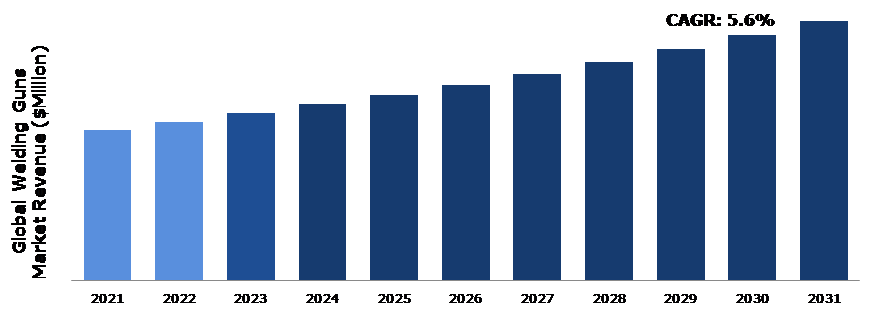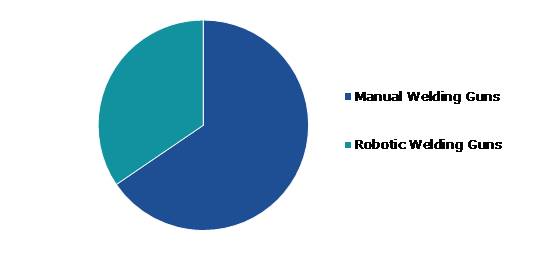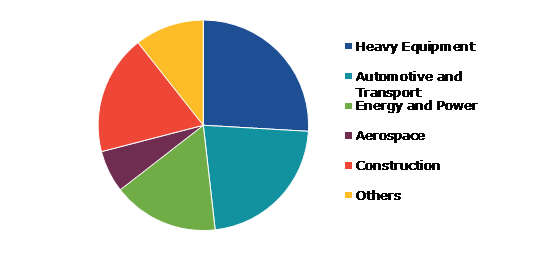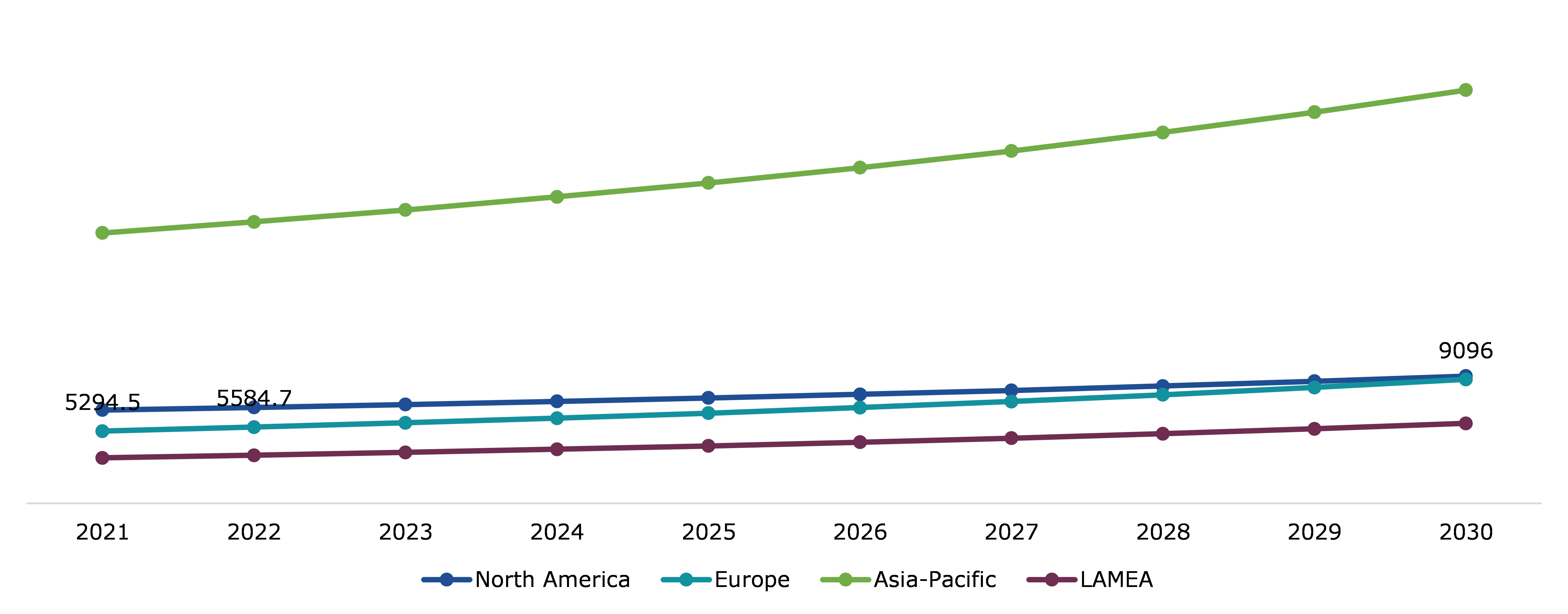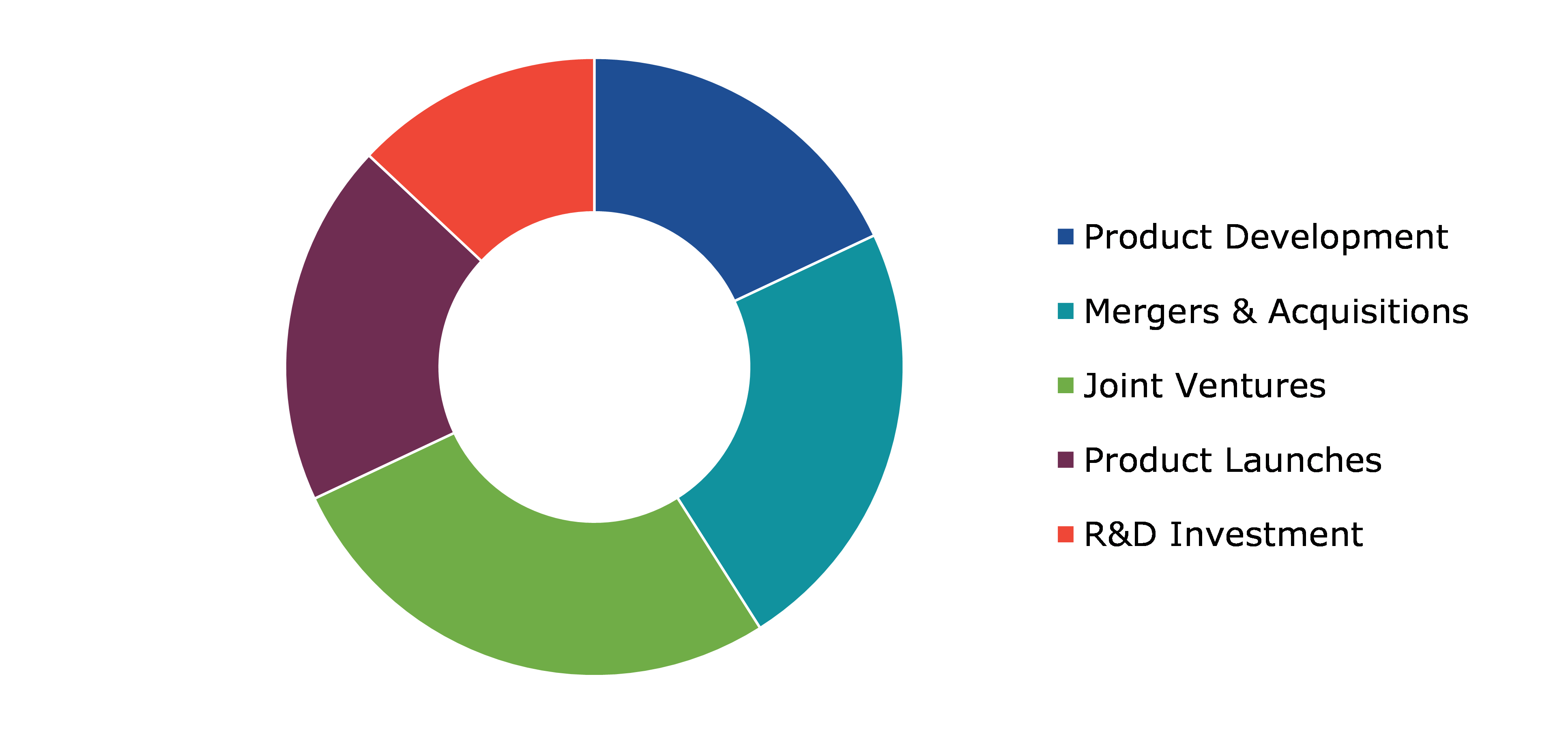Welding Guns Market Report
RA08678
Welding Guns Market by Type (Manual Welding Guns and Robotic Welding Guns), End-use Industry (Heavy Equipment, Automotive & Transport, Energy & Power, Aerospace, Construction, and Others), and Regional Analysis (North America, Europe, Asia-Pacific, and LAMEA): Global Opportunity Analysis and Industry Forecast, 2022-2031
Global Welding Guns Market Analysis
The Global Welding Guns Market Size was $189.8 million in 2021 and is predicted to grow with a CAGR of 5.6%, by generating a revenue of $327.2 million by 2031.
Global Welding Guns Market Synopsis
The welding guns market growth is being driven by the rising demand for welding equipment across numerous industries including the manufacturing, construction, and automotive. Welding guns are vital equipment for welding operations, therefore demand for them has greatly increased with the rise in demand for efficient and effective welding processes. Since welding guns are essential components of automated welding systems, the development of advanced welding technologies like robotic welding has also raised the demand for these instruments. Furthermore, as modern welding guns are made to increase safety, minimize operator fatigue, and increase overall efficiency, the rising emphasis on safety in welding operations has also contributed to the market expansion. These factors are anticipated to boost the welding guns industry growth in the upcoming years.
The high cost of manufacturing advanced welding guns is expected to be one of the major factors restraining the market growth. Welding guns are more expensive and less accessible for users due to the high cost of raw materials, complex components, and advanced manufacturing techniques required to make them. Also, particularly in price-sensitive countries, the availability of inexpensive welding guns from local manufacturers may serve as a limitation for the market expansion. These factors are anticipated to restrict the use of welding guns, hindering the market expansion during the forecast period.
The rising use of advanced welding techniques like friction welding and laser welding, both of which require specialized welding guns is the major factor predicted to create several opportunities for the key players operating in the welding guns market. The demand for advanced welding guns is projected to rise as welding guns are more extensively used across a variety of industries, opening up new business prospects for manufacturers in the upcoming years.
According to regional analysis, the Asia-Pacific welding guns market accounted for the highest market share in 2021. The region includes several emerging economies such as China and India, which are experiencing rapid industrialization and urbanization. The increasing demand for welding guns in various industries such as automotive, construction, and aerospace is driving the growth of the welding guns market in the region. The rising need for efficient and high-quality welding processes to reduce production time and costs is also contributing to the regional market growth.
Welding Guns Market Overview
Welding guns are handheld tools that are used in the welding procedure to deliver an electrical current to metal and make a bond between two pieces of metal. They are frequently used in the manufacturing and automotive industries for spot welding, which entails producing a weld at a specified location on a workpiece. Typically, welding guns consist of a handle, a trigger, and a copper electrode that conducts electricity to the metal. Depending on the use, they can be manual or automated.
COVID-19 Impact on Global Welding Guns Market
The COVID-19 outbreak had a significant impact on the welding guns market. The pandemic disrupted supply chains, forced businesses to adjust to new working situations, and caused fluctuations in demand. One of the major impacts of the pandemic on the welding guns market was a decline in demand owing to the slowdown in the manufacturing and construction sectors. Welding gun sales decreased as numerous businesses delayed or scaled back their welding projects. The supply chain for raw materials and components required for manufacturing welding guns has also been impacted by the pandemic. These supplies took longer to arrive due to the restrictions on movement and shipping, which affected manufacturing and resulted in raw material shortages. The post pandemic scenario of the welding guns market is positive as there is a rising adoption of automation and robotics in the welding industry, which is expected to create ample growth opportunities for welding gun manufacturers. Especially, the demand for automated welding guns is anticipated to increase as companies seek to reduce their dependence on manual labor and improve efficiency.
Rising Demand for Welding Guns from Various End-Use Industries to Drive the Market Growth
The demand for welding guns is influenced by the growth of various end-use industries such as automotive, construction, aerospace, and shipbuilding. These industries rely on welding guns for a wide range of applications, including fabrication, repair, and maintenance of structures and equipment. For instance, the automotive industry extensively uses welding guns for manufacturing vehicles' bodies and other critical components. The construction industry also uses welding guns for the fabrication of steel structures and other infrastructure projects. Similarly, the aerospace and shipbuilding industries use welding guns for assembling large structures and components. As these industries continue to expand, the demand for welding guns is likely to increase in the upcoming years. Moreover, technological advancements in welding gun design and functionality, such as the development of more efficient and lightweight guns, are also driving the market growth.
To know more about global welding guns market drivers, get in touch with our analysts here.
High Initial Cost of Welding Guns to Restrain the Market Growth
The high initial cost of welding guns is expected to act as a restraint for the welding guns market. The cost of welding guns varies depending on factors such as the type of gun, its power output, and features such as automation and control systems. High-end welding guns can cost thousands of dollars, which may be prohibitively expensive for small and medium-sized enterprises and those businesses who may have limited budgets. To address this challenge, some manufacturers offer rental options or financing plans to make welding guns more accessible to businesses with limited budgets. In addition, there are lower-cost options available that may not have all the features of high-end welding guns but can still provide adequate performance for certain welding applications, which is anticipated to hamper the welding guns market growth.
Increasing Awareness About Safety of Workers to Drive Excellent Opportunities
Welding is a hazardous job, and safety is of paramount importance. There is a significant opportunity for welding gun manufacturers to tap into the increasing demand for safety-focused equipment in the welding industry. With increased awareness of the hazards associated with welding, workers and employers are placing a greater emphasis on safety equipment that can mitigate those risks. Manufacturers can capitalize on this trend by developing welding guns with enhanced safety features, such as improved shielding and ventilation, automatic shut-off systems, and ergonomic designs that reduce operator fatigue and strain. By emphasizing the safety benefits of these products, manufacturers can differentiate themselves in the marketplace and attract customers who prioritize worker safety. In addition, manufacturers are also investing in R&D to create innovative new welding gun technologies that further enhance safety while improving productivity and efficiency. By staying at the forefront of these technological advances, manufacturers can position themselves as leaders in the welding industry and capture a larger share of the market.
To know more about global welding gun market opportunities, get in touch with our analysts here.
Global Welding Guns Market, by Type
Based on type, the market has been divided into manual welding guns and robotic welding guns. Among these, the manual welding guns sub-segment accounted for the highest market share in 2021, whereas the robotic welding guns sub-segment is estimated to show the fastest growth during the forecast period.
Global Welding Guns Market Size, by Type, 2021
Source: Research Dive Analysis
The manual welding guns sub-segment accounted for the highest market share in 2021. Manual welding guns are widely used in welding applications that require precision and control. They are preferred over automated welding guns in applications where the welds are complex or require a higher level of customization. Manual welding guns offer greater flexibility in terms of positioning and maneuverability. They allow welders to access tight spaces and work in areas where automated welding systems cannot reach. In addition, manual welding guns are typically more affordable than automated systems, making them a popular choice for small and medium-sized businesses. Furthermore, advances in technology have led to the development of lighter, more ergonomic manual welding guns that reduce operator fatigue and increase productivity. This has further driven the demand for manual welding guns in the welding industry. The rising demand for precision welding applications, greater flexibility, affordability, and advancements in technology are the key drivers of the manual welding guns segment in the welding guns market.
The robotic welding guns sub-segment is anticipated to show the fastest growth during the forecast period. Robotic welding guns offer a high level of accuracy, efficiency, and consistency in the welding process, which is driving their demand in various industries. Robotic welding guns are used in automated welding systems that can perform complex welding tasks with high precision and speed. These guns are becoming increasingly popular in industries such as automotive, aerospace, and construction, where there is a high demand for consistent and high-quality welding. The use of robotic welding guns also reduces the risk of workplace accidents and injuries, as they can perform welding tasks in hazardous environments or areas that are difficult to access for human welders. The rising demand for automation, increased efficiency, and safety in welding processes are the primary drivers of the robotic welding guns segment in the welding guns market.
Global Welding Guns Market, by End-use Industry
Based on end-use industry, the market has been divided into heavy equipment, automotive & transport, energy & power, aerospace, construction, and others. Among these, the heavy equipment sub-segment accounted for the highest revenue share in 2021.
Global Welding Guns Market Share, by End-use Industry, 2021
Source: Research Dive Analysis
The heavy equipment sub-segment accounted for the highest market share in 2021. The demand for heavy equipment welding guns is influenced by technological advancements, as new welding techniques and equipment are developed. Heavy equipment in the construction and manufacturing industries require robust and efficient welding equipment for various applications. Welding guns are essential tools for heavy equipment maintenance and repair, making them an integral part of the industry. The technological advancements in welding guns have led to the development of more powerful and durable welding guns that can handle heavy-duty welding tasks. These factors are anticipated to boost the growth of the heavy equipment sub-segment during the forecast period.
Global Welding Guns Market, Regional Insights
The welding gun market was investigated across North America, Europe, Asia-Pacific, and LAMEA.
Global Welding Guns Market Size & Forecast, by Region, 2021-2031 (USD Million)
Source: Research Dive Analysis
The Market for Welding Guns in Asia-Pacific was the Most Dominant
The Asia-Pacific welding guns market accounted for the highest market share in 2021, due to several factors such as the rising demand for welding guns in various industries such as automotive, construction, and aerospace. The region is experiencing rapid industrialization, and the increasing number of infrastructure projects are further boosting the demand for welding guns. Moreover, the rising adoption of advanced welding technologies such as robotic welding is also driving the growth of the welding guns market in the region. Many countries in Asia-Pacific are investing heavily in automation, and the increasing need for efficient and high-quality welding processes is driving the demand for welding guns. In addition, the rising trend of electric vehicles in the automotive industry is creating a significant opportunity for the welding guns market in the region. The manufacturing of electric vehicles requires a different welding process that requires specialized welding guns, which are in high demand in the region. The rising need for efficient and high-quality welding processes to reduce production time and costs is also contributing to the regional market growth.
Competitive Scenario in the Global Welding Guns Market
Investment and agreement are common strategies followed by major market players. For instance, in 2021, Miller Electric launched a new line of welding guns called the MDX series. The guns feature an ergonomic handle and are designed for improved operator comfort and reduced fatigue.
Source: Research Dive Analysis
Some of the leading welding guns market players are Arm Welders, Düring Schweißtechnik GmbH, The Lincoln Electric Company, Miller Electric Mfg. LLC, ABICOR BINZEL, NIMAK GmbH, Stellantis N.V., ESAB, Milco Manufacturing, and OBARA CORP.
| Aspect | Particulars |
| Historical Market Estimations | 2020 |
| Base Year for Market Estimation | 2021 |
| Forecast Timeline for Market Projection | 2022-2031 |
| Geographical Scope | North America, Europe, Asia-Pacific, and LAMEA |
| Segmentation by Type |
|
| Segmentation by End-use Industry |
|
| Key Companies Profiled |
|
Q1. What is the size of the global welding guns market?
A. The size of the global welding guns market was over $189.8 million in 2021 and is projected to reach $327.2 million by 2031.
Q2. Which are the major companies in the welding guns market?
A. Arm Welders, Düring Schweißtechnik GmbH, and The Lincoln Electric Company are some of the key players in the global welding guns market.
Q3. Which region, among others, possesses greater investment opportunities in the future?
A. Asia-Pacific possesses great investment opportunities for investors in the future.
Q4. What will be the growth rate of the Asia-Pacific welding guns market?
A. Asia-Pacific welding guns market is anticipated to grow at 6.0% CAGR during the forecast period.
Q5. What are the strategies opted by the leading players in this market?
A. Agreement and investment are the two key strategies opted by the operating companies in this market.
Q6. Which companies are investing more on R&D practices?
A. Stellantis N.V., ESAB, Milco Manufacturing, and OBARA CORP are the companies investing more on R&D activities for developing new products and technologies.
1.Research Methodology
1.1.Desk Research
1.2.Real time insights and validation
1.3.Forecast model
1.4.Assumptions and forecast parameters
1.5.Market size estimation
1.5.1.Top-down approach
1.5.2.Bottom-up approach
2.Report Scope
2.1.Market definition
2.2.Key objectives of the study
2.3.Report overview
2.4.Market segmentation
2.5.Overview of the impact of COVID-19 on Global Welding Guns market
3.Executive Summary
4.Market Overview
4.1.Introduction
4.2.Growth impact forces
4.2.1.Drivers
4.2.2.Restraints
4.2.3.Opportunities
4.3.Market value chain analysis
4.3.1.List of raw material suppliers
4.3.2.List of manufacturers
4.3.3.List of distributors
4.4.Innovation & sustainability matrices
4.4.1.Technology matrix
4.4.2.Regulatory matrix
4.5.Porter’s five forces analysis
4.5.1.Bargaining power of suppliers
4.5.2.Bargaining power of consumers
4.5.3.Threat of substitutes
4.5.4.Threat of new entrants
4.5.5.Competitive rivalry intensity
4.6.PESTLE analysis
4.6.1.Political
4.6.2.Economical
4.6.3.Social
4.6.4.Technological
4.6.5.Environmental
4.7.Impact of COVID-19 on Welding Guns market
4.7.1.Pre-covid market scenario
4.7.2.Post-covid market scenario
5.Welding Guns Market Analysis, by Type
5.1.Overview
5.2.Manual Welding Guns
5.2.1.Definition, key trends, growth factors, and opportunities
5.2.2.Market size analysis, by region,2021-2031
5.2.3.Market share analysis, by country,2021-2031
5.3.Robotic Welding Guns
5.3.1.Definition, key trends, growth factors, and opportunities
5.3.2.Market size analysis, by region,2021-2031
5.3.3.Market share analysis, by country,2021-2031
5.4.Research Dive Exclusive Insights
5.4.1.Market attractiveness
5.4.2.Competition heatmap
6.Welding Guns Market Analysis, by End-use Industry
6.1.Heavy Equipment
6.1.1.Definition, key trends, growth factors, and opportunities
6.1.2.Market size analysis, by region,2021-2031
6.1.3.Market share analysis, by country,2021-2031
6.2.Automotive & Transport
6.2.1.Definition, key trends, growth factors, and opportunities
6.2.2.Market size analysis, by region,2021-2031
6.2.3.Market share analysis, by country,2021-2031
6.3.Energy & Power
6.3.1.Definition, key trends, growth factors, and opportunities
6.3.2.Market size analysis, by region,2021-2031
6.3.3.Market share analysis, by country,2021-2031
6.4.Aerospace
6.4.1.Definition, key trends, growth factors, and opportunities
6.4.2.Market size analysis, by region,2021-2031
6.4.3.Market share analysis, by country,2021-2031
6.5.Construction
6.5.1.Definition, key trends, growth factors, and opportunities
6.5.2.Market size analysis, by region,2021-2031
6.5.3.Market share analysis, by country,2021-2031
6.6.Others
6.6.1.Definition, key trends, growth factors, and opportunities
6.6.2.Market size analysis, by region,2021-2031
6.6.3.Market share analysis, by country,2021-2031
6.7.Research Dive Exclusive Insights
6.7.1.Market attractiveness
6.7.2.Competition heatmap
7.Welding Guns Market, by Region
7.1.North America
7.1.1.U.S.
7.1.1.1.Market size analysis, by Type,2021-2031
7.1.1.2.Market size analysis, by End-use Industry,2021-2031
7.1.2.Canada
7.1.2.1.Market size analysis, by Type,2021-2031
7.1.2.2.Market size analysis, by End-use Industry,2021-2031
7.1.3.Mexico
7.1.3.1.Market size analysis, by Type,2021-2031
7.1.3.2.Market size analysis, by End-use Industry,2021-2031
7.1.4.Research Dive Exclusive Insights
7.1.4.1.Market attractiveness
7.1.4.2.Competition heatmap
7.2.Europe
7.2.1.Germany
7.2.1.1.Market size analysis, by Type,2021-2031
7.2.1.2.Market size analysis, by End-use Industry,2021-2031
7.2.2.UK
7.2.2.1.Market size analysis, by Type,2021-2031
7.2.2.2.Market size analysis, by End-use Industry,2021-2031
7.2.3.France
7.2.3.1.Market size analysis, by Type,2021-2031
7.2.3.2.Market size analysis, by End-use Industry,2021-2031
7.2.4.Spain
7.2.4.1.Market size analysis, by Type,2021-2031
7.2.4.2.Market size analysis, by End-use Industry,2021-2031
7.2.5.Italy
7.2.5.1.Market size analysis, by Type,2021-2031
7.2.5.2.Market size analysis, by End-use Industry,2021-2031
7.2.6.Rest of Europe
7.2.6.1.Market size analysis, by Type,2021-2031
7.2.6.2.Market size analysis, by End-use Industry,2021-2031
7.2.7.Research Dive Exclusive Insights
7.2.7.1.Market attractiveness
7.2.7.2.Competition heatmap
7.3.Asia-Pacific
7.3.1.China
7.3.1.1.Market size analysis, by Type,2021-2031
7.3.1.2.Market size analysis, by End-use Industry,2021-2031
7.3.2.Japan
7.3.2.1.Market size analysis, by Type,2021-2031
7.3.2.2.Market size analysis, by End-use Industry,2021-2031
7.3.3.India
7.3.3.1.Market size analysis, by Type,2021-2031
7.3.3.2.Market size analysis, by End-use Industry,2021-2031
7.3.4.Australia
7.3.4.1.Market size analysis, by Type,2021-2031
7.3.4.2.Market size analysis, by End-use Industry,2021-2031
7.3.5.South Korea
7.3.5.1.Market size analysis, by Type,2021-2031
7.3.5.2.Market size analysis, by End-use Industry,2021-2031
7.3.6.Rest of Asia-Pacific
7.3.6.1.Market size analysis, by Type,2021-2031
7.3.6.2.Market size analysis, by End-use Industry,2021-2031
7.3.7.Research Dive Exclusive Insights
7.3.7.1.Market attractiveness
7.3.7.2.Competition heatmap
7.4.LAMEA
7.4.1.Brazil
7.4.1.1.Market size analysis, by Type,2021-2031
7.4.1.2.Market size analysis, by End-use Industry,2021-2031
7.4.2.Saudi Arabia
7.4.2.1.Market size analysis, by Type,2021-2031
7.4.2.2.Market size analysis, by End-use Industry,2021-2031
7.4.3.UAE
7.4.3.1.Market size analysis, by Type,2021-2031
7.4.3.2.Market size analysis, by End-use Industry,2021-2031
7.4.4.South Africa
7.4.4.1.Market size analysis, by Type,2021-2031
7.4.4.2.Market size analysis, by End-use Industry,2021-2031
7.4.5.Rest of LAMEA
7.4.5.1.Market size analysis, by Type,2021-2031
7.4.5.2.Market size analysis, by End-use Industry,2021-2031
7.4.6.Research Dive Exclusive Insights
7.4.6.1.Market attractiveness
7.4.6.2.Competition heatmap
8.Competitive Landscape
8.1.Top winning strategies, 2021
8.1.1.By strategy
8.1.2.By year
8.2.Strategic overview
8.3.Market share analysis, 2021
9.Company Profiles
9.1.Arm Welders
9.1.1.Overview
9.1.2.Business segments
9.1.3.Product portfolio
9.1.4.Financial performance
9.1.5.Recent developments
9.1.6.SWOT analysis
9.2.Düring Schweißtechnik GmbH
9.2.1.Overview
9.2.2.Business segments
9.2.3.Product portfolio
9.2.4.Financial performance
9.2.5.Recent developments
9.2.6.SWOT analysis
9.3.The Lincoln Electric Company
9.3.1.Overview
9.3.2.Business segments
9.3.3.Product portfolio
9.3.4.Financial performance
9.3.5.Recent developments
9.3.6.SWOT analysis
9.4.Miller Electric Mfg. LLC
9.4.1.Overview
9.4.2.Business segments
9.4.3.Product portfolio
9.4.4.Financial performance
9.4.5.Recent developments
9.4.6.SWOT analysis
9.5.ABICOR BINZEL
9.5.1.Overview
9.5.2.Business segments
9.5.3.Product portfolio
9.5.4.Financial performance
9.5.5.Recent developments
9.5.6.SWOT analysis
9.6.NIMAK GmbH
9.6.1.Overview
9.6.2.Business segments
9.6.3.Product portfolio
9.6.4.Financial performance
9.6.5.Recent developments
9.6.6.SWOT analysis
9.7.Stellantis N.V.
9.7.1.Overview
9.7.2.Business segments
9.7.3.Product portfolio
9.7.4.Financial performance
9.7.5.Recent developments
9.7.6.SWOT analysis
9.8.ESAB
9.8.1.Overview
9.8.2.Business segments
9.8.3.Product portfolio
9.8.4.Financial performance
9.8.5.Recent developments
9.8.6.SWOT analysis
9.9.Milco Manufacturing
9.9.1.Overview
9.9.2.Business segments
9.9.3.Product portfolio
9.9.4.Financial performance
9.9.5.Recent developments
9.9.6.SWOT analysis
9.10.OBARA CORP
9.10.1.Overview
9.10.2.Business segments
9.10.3.Product portfolio
9.10.4.Financial performance
9.10.5.Recent developments
9.10.6.SWOT analysis
Welding is a vital process in the field of metalwork, allowing for the fusion of two or more materials to create a strong and durable bond. A welding gun is an indispensable tool that provides the required amount of heat and electricity to create a successful weld.
Welding guns come in different variations, each designed for specific welding techniques and applications. The two most used types are MIG (Metal Inert Gas) and TIG (Tungsten Inert Gas) welding guns. MIG guns are widely used due to their versatility and ease of use. They employ a consumable wire electrode that continuously feeds through the gun, melting, and fusing the base metals. On the other hand, TIG welding guns utilize a non-consumable tungsten electrode to create an arc. They are favored for their precision and ability to weld various metals, including stainless steel and aluminum. TIG welding guns find applications in industries such as aerospace, electronics, and sculpture, where aesthetic and precise welds are crucial.
Forecast Analysis of the Global Welding Guns Market
According to the report published by Research Dive, the global welding guns market is anticipated to generate a revenue of $327.2 million and rise at a CAGR of 5.6% during the analysis timeframe from 2022-2031.
The increasing demand for welding guns from various end-use industries such as construction, automotive, aerospace, and shipbuilding for a variety of applications such as maintenance of structures and equipment, repair, and many more are predicted to foster the growth of the welding guns market throughout the analysis timeframe. Moreover, the increasing demand for safety-focused equipment in the welding industry for workers and employers due to the increasing awareness of hazards associated with welding among them is expected to create immense growth opportunities for the welding guns market over the estimated period. However, the high initial cost of welding guns may hinder the growth of the market during the forecast period.
The major players of the welding guns market include OBARA CORP., Arm Welders, Milco Manufacturing, Düring Schweißtechnik GmbH, ESAB, The Lincoln Electric Company, Stellantis N.V., Miller Electric Mfg. LLC, NIMAK GmbH, ABICOR BINZEL, and many more.
Welding Guns Market Key Developments
The key companies operating in the industry are adopting various growth strategies & business tactics such as partnerships, collaborations, mergers & acquisitions, and launches to maintain a robust position in the overall market, which is subsequently helping the global welding guns market to grow exponentially.
For instance,
- In August 2022, Miller Electric Mfg. LLC, a leading American-based arc welding and cutting equipment manufacturing company, announced its partnership with Part Analytics, a Venture-backed startup focused on transforming direct material procurement by digitizing manual processes. With this partnership, the companies aimed to help various organizations overcome supply chain changes and promote new equipment development including welding guns.
- In October 2022, Lincoln Electric Holding Inc., a global manufacturer of welding products, arc welding components, welding consumables, and many more, announced the launch of its new product, namely, the POWER MIG 211i MIG welder. It is a rugged 200-amp machine that is designed for flux-cored, MIG, and spool-gun welding.
- In February 2023, Stellantis, a multinational automotive manufacturing corporation, announced to make investments in Indiana Transmission, Kokomo Transmission, and Kokomo Casting Plants to manufacture new electric drive modules that will help power future electric vehicles assembling in North America.
Most Profitable Region
The Asia-Pacific region of the welding guns market held the maximum market share in 2021. This is mainly because of the growing demand for welding guns across various industries including aerospace, construction, and automotive. Moreover, the increasing demand for high-quality and efficient welding processes and the increasing trend of electric vehicles in the automotive industry across the region are expected to drive the regional growth of the market over the analysis period.
Covid-19 Impact on the Welding Guns Market
The rise of the Covid-19 pandemic has brought several uncertainties across various industries including the welding guns market. The slowdown in the manufacturing and construction sectors owing to the spontaneous spread of the deadly virus has decreased the demand for welding guns during the pandemic period. Moreover, the disruptions in supply chains have resulted in a shortage of raw materials and components which have badly impacted the production of welding guns. However, the increasing adoption of automation and robotics in the welding industry is expected to provide extensive growth opportunities for the welding guns market post-pandemic period.
Personalize this research
- Triangulate with your own data
- Request your format and definition
- Get a deeper dive on a specific application, geography, customer or competitor
- + 1-888-961-4454 Toll - Free
- support@researchdive.com

